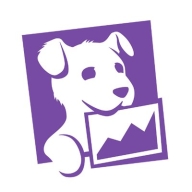

Datadog and Upwind compete in the field of monitoring and analytics. Datadog has the upper hand due to its comprehensive feature set and robust integrations.
Features: Datadog offers extensive integrations, real-time monitoring, and granular insights suitable for diverse IT infrastructures. Upwind focuses on advanced predictive analytics, customizable dashboards, and predictive analysis tools, attracting organizations seeking innovative solutions.
Ease of Deployment and Customer Service: Datadog is known for straightforward deployment and efficient support services with clear documentation. Upwind provides excellent support but may require more technical expertise during deployment. Datadog's easy integration gives it an edge over Upwind's more complex setup process.
Pricing and ROI: Datadog's flexible pricing structure aligns with its scalable nature, often resulting in worthwhile ROI for organizations with significant monitoring needs. Upwind might present a higher initial setup cost but justifies its price with custom solutions, leading to high ROI in large-scale or niche deployments. Datadog offers cost-effective solutions with varied pricing tiers, while Upwind's personalized approach provides substantial long-term benefits.
| Product | Market Share (%) |
|---|---|
| Datadog | 1.9% |
| Upwind | 2.6% |
| Other | 95.5% |

| Company Size | Count |
|---|---|
| Small Business | 78 |
| Midsize Enterprise | 42 |
| Large Enterprise | 82 |
Datadog integrates extensive monitoring solutions with features like customizable dashboards and real-time alerting, supporting efficient system management. Its seamless integration capabilities with tools like AWS and Slack make it a critical part of cloud infrastructure monitoring.
Datadog offers centralized logging and monitoring, making troubleshooting fast and efficient. It facilitates performance tracking in cloud environments such as AWS and Azure, utilizing tools like EC2 and APM for service management. Custom metrics and alerts improve the ability to respond to issues swiftly, while real-time tools enhance system responsiveness. However, users express the need for improved query performance, a more intuitive UI, and increased integration capabilities. Concerns about the pricing model's complexity have led to calls for greater transparency and control, and additional advanced customization options are sought. Datadog's implementation requires attention to these aspects, with enhanced documentation and onboarding recommended to reduce the learning curve.
What are Datadog's Key Features?In industries like finance and technology, Datadog is implemented for its monitoring capabilities across cloud architectures. Its ability to aggregate logs and provide a unified view enhances reliability in environments demanding high performance. By leveraging real-time insights and integration with platforms like AWS and Azure, organizations in these sectors efficiently manage their cloud infrastructures, ensuring optimal performance and proactive issue resolution.
Upwind is an innovative platform designed to enhance efficiency and streamline operations, offering a comprehensive set of features tailored to tech-savvy users. It supports seamless integration, ensuring that businesses can optimize their workflows with minimal disruption.
Upwind stands out by providing solutions that address complex business challenges, delivering value through enhanced functionality and ease of use. Its ability to integrate with existing systems empowers users to tailor the platform according to specific operational needs. Users benefit from Upwind's user-friendly design, which facilitates quick adoption and minimizes the learning curve. The platform's adaptability makes it a valuable tool for businesses looking to increase agility and remain competitive in a rapidly evolving market.
What are Upwind's most valuable features?Upwind is implemented across industries like finance, manufacturing, and retail, where it supports diverse operational needs such as compliance, inventory management, and customer engagement. Businesses leverage Upwind to improve data accuracy, procedural efficacy, and customer satisfaction, demonstrating its versatility and effectiveness.
We monitor all Cloud Security Posture Management (CSPM) reviews to prevent fraudulent reviews and keep review quality high. We do not post reviews by company employees or direct competitors. We validate each review for authenticity via cross-reference with LinkedIn, and personal follow-up with the reviewer when necessary.